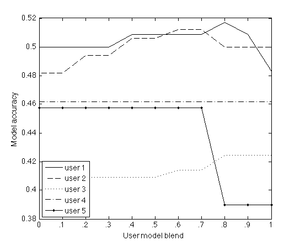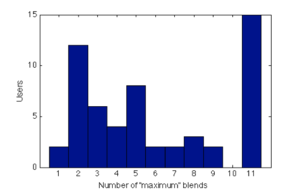Difference between revisions of "Blending layers of CUMULATE's user model"
(→Data) |
(→Publication) |
||
| (12 intermediate revisions by the same user not shown) | |||
| Line 63: | Line 63: | ||
=== Procedures === | === Procedures === | ||
| + | Out of 114 users who took the class 56 were chosen. The criteria was that the user had to cover at least 33% of problems (15/48) and at least 33% of examples (15/64). For each of the qualified users 11 user models were computed: with 0% to 100% of example browsing activity "blended" to the problem solving (by % here we mean numerical weighting not item filtering). | ||
| + | |||
| + | === Metrics === | ||
| + | * [http://en.wikipedia.org/wiki/Accuracy Accuracy] was used to measure the resulting user model quality | ||
| + | * For every user - the "best blend" - blended model (with 10% or more of example activity added) having the highest accuracy; if there is more than one such model, the smallest % of the blend is taken | ||
| + | * For each user - number of "best blends" - number of blended models (with 10% blend of example activity or more), where the accuracy is the highest | ||
| + | |||
| + | === Results === | ||
| + | [[Image:Blending layers of CUMULATE's user model. Study 1.users.png|thumb|'''100'''|Examples of blend effect on user model accuracy]] | ||
| + | [[Image:Blending layers of CUMULATE's user model. Study 1.histogram.png|thumb|'''100'''|Distribution of number of users for different "best" blends]] | ||
| + | * While looking at users' individual preferences, the best user blend seems to be superior to the 0%-blend: t = -5.38, p-value<.001 | ||
| + | * Comparison of uniform blends for all users to a 0%-blends, shows that 40% and 50% blends were significantly better than 0%-blend: t = -for both 2.05, p-value = .023 | ||
| + | * User separation into groups by the number of best blends yielded the following results | ||
| + | ** <span style="color:grey;">'''''Low'''''. 1 best blend only, 2 users. No further investigation performed.</span> | ||
| + | ** '''''Medium'''''. 2-4 best blends. 22 users. Here 90% blend had the highest significant edge over 0% blend: p-value = .037 | ||
| + | ** '''''High'''''. 5-9 best blends. 17 users. This group follows the global trend with 40% and 50% blends having best significant edge over 0% blend: p-value = .049 | ||
| + | ** <span style="color:grey;">'''''No difference'''''. 10 best blends (all blended models have same accuracy). 15 users. No further investigation performed.</span> | ||
| + | |||
| + | === Publication === | ||
| + | Yudelson, M., Sosnovsky, A. (2009). Retrospective evaluation of blended user modeling for adaptive educational systems. In: Weibelzahl, S., Masthoff., J., Paramythis, A., van Velsen, L. (Eds.) [http://www.easy-hub.org/hub/workshops/umap2009/index.html 6th Workshop on User-Centred Design and Evaluation of Adaptive Systems (UCDEAS)], pp. 34-43. June 26, 2009. Trento, Italy. ([[Media:UMAP09.UCDEAS.Yudelson.Retrosp. Eval. Blended UM For AES.pdf|slides]]) | ||
| + | |||
| + | === Addendum === | ||
| + | MATLAB code used for computation can be downloaded [[Media:CUMULATE blending user model layers study1 umap09 ucdeas matlab.src.tgz|here]]. | ||
| + | |||
| + | [[CUMULATE]] log data for the 6 Database Management Courses can be accessed [[CUMULATE_Usage_Logs#Database_Management_6_Course_Dataset|here]] | ||
| + | |||
| + | = Contacts = | ||
| + | [[User:Myudelson|Michael V. Yudelson]] | ||
Latest revision as of 21:04, 28 June 2009
| This page is under construction. More content will be added soon |
This work is focused on mutual influence of heterogeneous user activity types (reading texts, viewing examples, and solving problems) on user's knowledge of some educational domain. Ordinarily CUMULATE's considers them separately by classifying them to modeling tiers or levels, each corresponding to a level of Bloom's taxonomy of intellectual behavior. Great part of this work is devoted on cross-tier user modeling. Namely, how user activity can (positively) influence on another/other layer(s).
Contents
Study 1
In this study we have inspected the influence of the comprehension layer of CUMULATE's user model (viewing examples) on the application layer (solving problems). Our approach was to create "blends" of problem-solving tier of the user model and weighted (from 0 to 1, with .1 step) example viewing tier Our hypotheses were that:
- Using example browsing activity when modeling problem solving improves model accuracy
- Different users benefit from different “blends” of user model levels
In addition we wanted to se if
- There is a single optimal blend for all users, and. or
- Classes of users benefitting from different model blends can be determined
Data
We were using previously collected student usage logs collected from 4 Database Management courses offered during Fall 2007 and Spring 2008 semesters at the University of Pittsburgh and Dublin City University. Each course had roughly the same structure, an identical set of 48 problems served by SQLKnoT system, and an identical set of 64 examples served by WebEx system. Basic usage statistics are given in the table below.
| School | Semester | Level | No. of users | Avg. problem attempts | Avg. example views | Avg. distinct problems | Avg. distinct examples |
|---|---|---|---|---|---|---|---|
| U. of Pitt | Fall 2007 | U* | 27 | 156.40 | 189.00 | 29.96 | 32.07 |
| U. of Pitt | Fall 2007 | G | 20 | 61.70 | 104.70 | 29.95 | 29.10 |
| U. of Pitt | Spring 2008 | U | 15 | 26.94 | 46.65 | 16.35 | 10.29 |
| DCU | Spring 2008 | U | 52 | 81.68 | 257.25 | 22.82 | 38.63 |
- U – undergraduate, G – graduate
Procedures
Out of 114 users who took the class 56 were chosen. The criteria was that the user had to cover at least 33% of problems (15/48) and at least 33% of examples (15/64). For each of the qualified users 11 user models were computed: with 0% to 100% of example browsing activity "blended" to the problem solving (by % here we mean numerical weighting not item filtering).
Metrics
- Accuracy was used to measure the resulting user model quality
- For every user - the "best blend" - blended model (with 10% or more of example activity added) having the highest accuracy; if there is more than one such model, the smallest % of the blend is taken
- For each user - number of "best blends" - number of blended models (with 10% blend of example activity or more), where the accuracy is the highest
Results
- While looking at users' individual preferences, the best user blend seems to be superior to the 0%-blend: t = -5.38, p-value<.001
- Comparison of uniform blends for all users to a 0%-blends, shows that 40% and 50% blends were significantly better than 0%-blend: t = -for both 2.05, p-value = .023
- User separation into groups by the number of best blends yielded the following results
- Low. 1 best blend only, 2 users. No further investigation performed.
- Medium. 2-4 best blends. 22 users. Here 90% blend had the highest significant edge over 0% blend: p-value = .037
- High. 5-9 best blends. 17 users. This group follows the global trend with 40% and 50% blends having best significant edge over 0% blend: p-value = .049
- No difference. 10 best blends (all blended models have same accuracy). 15 users. No further investigation performed.
Publication
Yudelson, M., Sosnovsky, A. (2009). Retrospective evaluation of blended user modeling for adaptive educational systems. In: Weibelzahl, S., Masthoff., J., Paramythis, A., van Velsen, L. (Eds.) 6th Workshop on User-Centred Design and Evaluation of Adaptive Systems (UCDEAS), pp. 34-43. June 26, 2009. Trento, Italy. (slides)
Addendum
MATLAB code used for computation can be downloaded here.
CUMULATE log data for the 6 Database Management Courses can be accessed here


